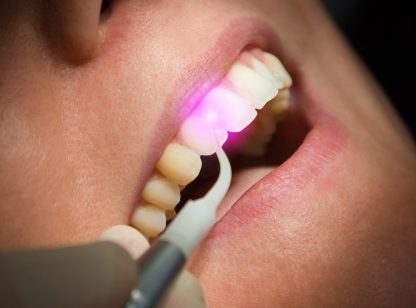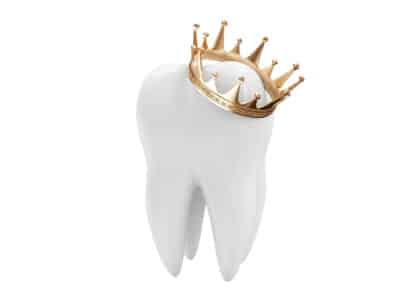Have you noticed that your teeth appear darker or have more stains? Fortunately, today there are many treatment options to help whiten the teeth and brighten your smile.
External versus internal staining. External staining of the teeth commonly results from colored foods or agents coming in contact with the enamel. Individuals who use tobacco or consume highly pigmented foods and drinks (coffee, tea, juice, red wine) will tend to have more discoloration and staining. Over-the-counter whitening agents such as whitening toothpaste, as well as routine dental cleanings, can help remove extrinsic stains from teeth. Internal staining occurs inside the tooth, usually near the dentin, and may be caused by certain genetic disorders or developmental factors such as fluorosis, which most commonly appears as faint white streaks on the teeth. Fluorosis can occur due to high exposure of fluoride at a young age when the teeth are still developing. Another common cause of internal staining is aging. As we age, the enamel of the tooth becomes thinner and more translucent, which causes the yellow dentin to show more readily than in younger teeth.
In-office versus over-the-counter whitening. Professional teeth whitening at a dental office is the most popular form of whitening and provides the quickest results. There are a range of techniques and brands used to bleach the teeth. Depending on the whitening system used, treatment can be a one-time appointment which involves applying professional strength bleaching material to the teeth for multiple rounds until desired shade is obtained. The whitening agent most commonly used for in-office bleaching is carbamide peroxide, which releases a portion of its content as hydrogen peroxide which works as the oxidizing agent. Another common in-office treatment includes fabricating custom fitted trays to use at home with professional strength bleaching gel either worn during the day or at night, depending on what your dentist determines is best. The professional strength bleaching gel is stronger compared to the gel in over-the-counter strips.
Over-the-counter bleaching options usually contain either carbamide peroxide or hydrogen peroxide, but at lower concentration compared to in-office bleaching treatments. Options include whitening strips, toothpastes or generic trays with whitening gel to place over the teeth.
Whitening limitations. Although teeth whitening can produce positive results for a brighter smile, whitening is not a one-time permanent fix. In order to maintain the desired shade, routine maintenance (either at home or in office) may be needed to keep teeth as white as desired. Limiting colored foods and beverages can also help prevent staining. It is also important to note that whitening treatment only works on natural teeth and does not work on certain dental materials such as resin fillings, porcelain veneers and porcelain crowns.
If you are considering a smile makeover including dental restorations, it is best to have whitening done a few weeks prior in order to reach the desired shade, and then have dental restorations match. Contact your dentist if you are interested in learning more about whitening treatment options.
Sarah Khoshniyati (“Dr. Sarah”) is a dentist with Palm Desert Smiles and can be reached at (760) 568.3602. Visit www.PalmDesertSmiles.com.















































Comments (0)